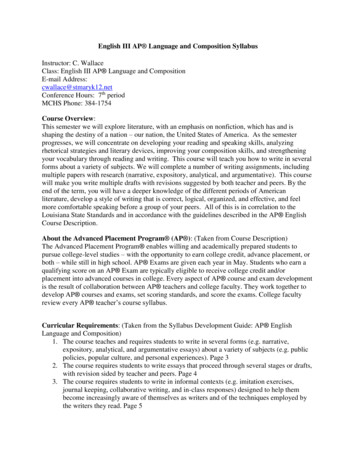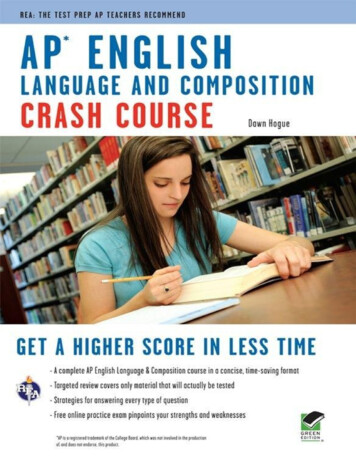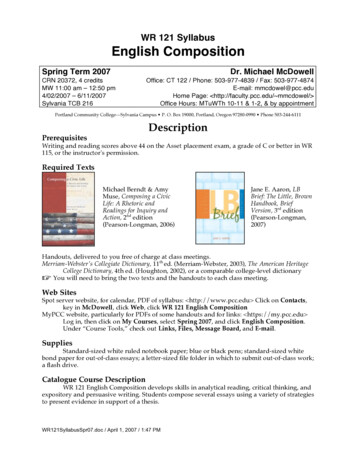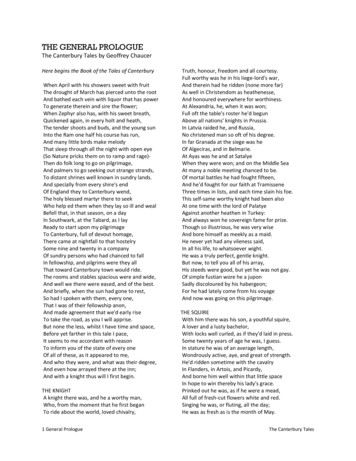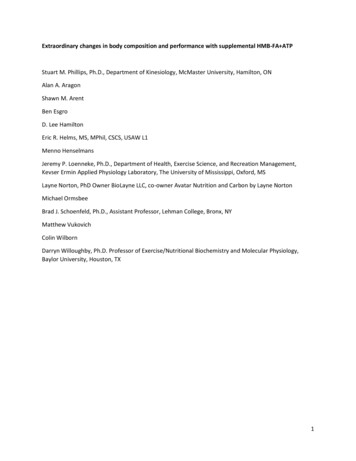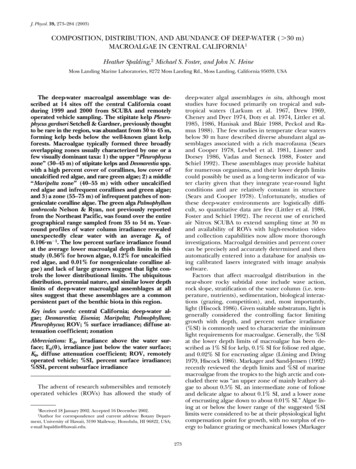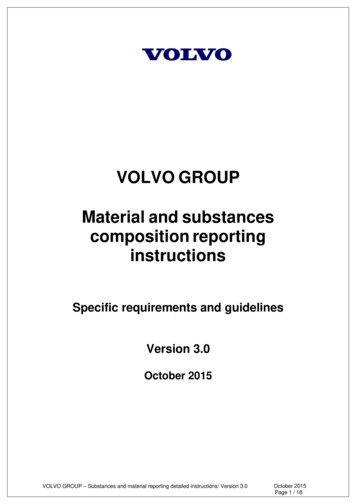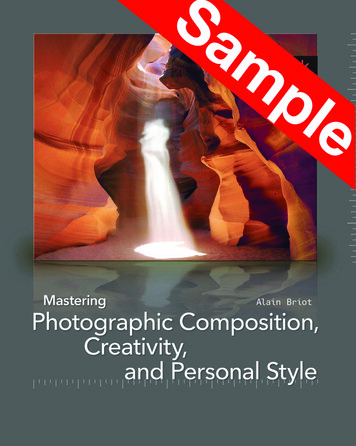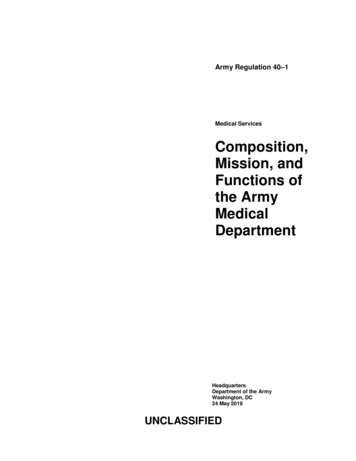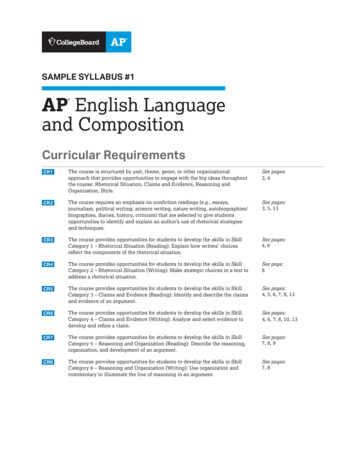
Transcription
SAMPLE SYLLABUS #1AP English Languageand Composition Curricular RequirementsCR1The course is structured by unit, theme, genre, or other organizationalapproach that provides opportunities to engage with the big ideas throughoutthe course: Rhetorical Situation, Claims and Evidence, Reasoning andOrganization, Style.See pages:3, 4CR2The course requires an emphasis on nonfiction readings (e.g., essays,journalism, political writing, science writing, nature writing, autobiographies/biographies, diaries, history, criticism) that are selected to give studentsopportunities to identify and explain an author’s use of rhetorical strategiesand techniques.See pages:3, 5, 13CR3The course provides opportunities for students to develop the skills in SkillCategory 1 – Rhetorical Situation (Reading): Explain how writers’ choicesreflect the components of the rhetorical situation.See pages:4, 6CR4The course provides opportunities for students to develop the skills in SkillCategory 2 – Rhetorical Situation (Writing): Make strategic choices in a text toaddress a rhetorical situation.See page:8CR5The course provides opportunities for students to develop the skills in SkillCategory 3 – Claims and Evidence (Reading): Identify and describe the claimsand evidence of an argument.See pages:4, 5, 6, 7, 8, 13CR6The course provides opportunities for students to develop the skills in SkillCategory 4 – Claims and Evidence (Writing): Analyze and select evidence todevelop and refine a claim.See pages:4, 6, 7, 8, 10, 13CR7The course provides opportunities for students to develop the skills in SkillCategory 5 – Reasoning and Organization (Reading): Describe the reasoning,organization, and development of an argument.See pages:7, 8, 9CR8The course provides opportunities for students to develop the skills in SkillCategory 6 – Reasoning and Organization (Writing): Use organization andcommentary to illuminate the line of reasoning in an argument.See pages:7, 8
CR9The course provides opportunities for students to develop the skills in SkillCategory 7 – Style (Reading): Explain how writers’ stylistic choices contributeto the purpose of an argument.See page:10CR10The course provides opportunities for students to develop the skills in SkillCategory 8 – Style (Writing): Select words and use elements of composition toadvance an argument.See pages:10, 11, 12CR11The course provides opportunities for students to write argumentative essayssynthesizing material from a variety of sources.See pages:7, 9CR12The course provides opportunities for students to write essays analyzingauthors’ rhetorical choices.See pages:10, 12CR13The course provides opportunities for students to write essays that proceedthrough multiple stages or drafts, including opportunities for conferring andcollaborating with teacher and/or peers.See pages:9, 12
Advanced PlacementEnglish Language andComposition Sample Syllabus #1Course DescriptionThe AP English Language course provides students with the opportunity to read rigoroustexts from various eras and in different genres, analyzing the big ideas of rhetoricalsituation, claims/evidence, reasoning/organization, and style. CR1 Students use giventexts to reach the goal of effective writing and analysis: they will read and annotate textsfrom a critical perspective in order to craft well-reasoned essays and personal reflectionsin response.The course is structured both thematically and chronologically, based on districtrequirements and College Board’s unit guide. The over-arching theme for the course isthat of power. The district requires all juniors to read The Crucible, Macbeth, and The GreatGatsby; I then extend and explore the basic readings by asking students to work withnonfiction titles that expand on the ideas stated or implied in the required texts.The textbook for the course is Bedford’s Language of Composition (2nd edition), supplyingmany of the nonfiction readings for the course. Some materials from Language ofComposition, 3rd edition, are also used. Additional readings come from such variedsources as Project Gutenberg, current events, national publications, and any otherresources that seems likely to provide for rigor, depth, and high interest. CR2Big IdeasRhetorical Situation: Individuals write within a particular situation and make strategicwriting choices based on that situation.Claims and Evidence: Writers make claims about subjects, rely on evidence that supportsthe reasoning that justifies the claim, and often acknowledge or respond to other, possiblyopposing, arguments.CR1The syllabus must includean outline of course contentby unit, theme, genre,or other organizationalapproach that alsodemonstrates the inclusionof the big ideas. The bigideas must be explicitlystated in the syllabus.CR2The syllabus must includea representative list ofreadings or indicate thereadings used within eachunit of study to demonstratean emphasis on nonfiction.The majority of texts mustbe nonfiction.Reasoning and Organization: Writers guide understanding of a text’s lines of reasoningand claims through that text’s organization and integration of evidence.Style: The rhetorical situation informs the strategic stylistic choices that writers make.Student PracticeThroughout each unit, Topic Questions will be provided to help students check theirunderstanding. The Topic Questions are especially useful for confirming understandingof difficult or foundational topics before moving on to new content or skills that buildupon prior topics. Topic Questions can be assigned before, during, or after a lesson, andas in-class work or homework. Students will get rationales for each Topic Question thatwill help them understand why an answer is correct or incorrect, and their results willreveal misunderstandings to help them target the content and skills needed foradditional practice.At the end of each unit or at key points within a unit, Personal Progress Checks willbe provided in class or as homework assignments in AP Classroom. Students will get apersonal report with feedback on every topic, skill, and question that they can use to chartAP-Course Audit Teacher Resources 2020 College Board3
Advanced Placement English Language and Composition Sample Syllabus #1their progress, and their results will come with rationales that explain every question’sanswer. One to two class periods are set aside to re-teach skills based on the results of thePersonal Progress Checks.Course UnitsThe units below show the general scheduling for the course. Please note that our schoolyear extends to mid-June. My students will complete Unit 9 before the AP Exam. After theAP Exam, students will polish their college essays and read the Thornton Wilder play TheSkin of Our Teeth, along with nonfiction pieces to support Wilder’s ideas about humanity.Unit One: The Power of Perspective:The Author and The Audience CR1Topic: CommunityBig Ideas: Rhetorical Situation; Claims and EvidenceSkills: 1.A, 3.A, 4.AIn Unit 1, students are laying a foundation for the work throughout the year. Accordingly,they will begin with a number of foundational texts, including those listed at the bottomof this section. Students will identify, reflect on, and write about rhetorical situation in avariety of activities.Activities:1. Students will read Chapter 1 in Everyday Use: Rhetoric at Work in Reading and Writing,which describes rhetorical situation and the rhetorical triangle. Students havecompleted the reading of a nonfiction book over the summer. During the first twoweeks of school, they will submit a series of reflections written during the summer;these reactions will include their thoughts on style, organization, subject matter, andother items. Before discussing their summer reading, they will read PresidentGeorge W. Bush’s “9/11 Speech,” using the rhetorical triangle to identify the parts ofthe rhetorical situation, as well as the author’s understanding of audience. Then, theywill discuss in groups the components of the rhetorical situation addressed in thesummer reading book (Skill 1.A). CR3 After a discussion in class of claim, evidence,commentary, student groups will then list in bullet-point form the major claim,evidence, and commentary in one chapter or segment in the book (Skill 3.A). Next,students will develop a group paragraph that explicates claim, one piece of evidence,and commentary from the book. Finally, each student will continue the groupparagraph by adding an additional example of claim, evidence, and commentary.2. Before listening to Malala Yousafzai’s speech to the United Nations, students willresearch some of the unfamiliar allusions, such as these: Mohammed al-Jinnah, BachaKhan, the partition of India, the role of Gandhi and nonviolence in that partition,and other items. After reporting to the class, students will listen to and follow thetranscript of Malala’s speech to the United Nations. As a class, they will brainstormthe elements of the rhetorical situation in the speech, particularly noting exigenceand audience, both explicit and implied (Skill 1.A). They will also pinpoint elementsof claim, evidence, and commentary (Skill 3.A). The class will generate a rubric,listing items to be included in the paragraphs they will write. Students will thendivide into groups; each group member will contribute a paragraph on one elementof the rhetorical situation, using claim, evidence, commentary in the paragraph (Skill4.A). CR3 CR5 CR6 As a final step, students will exchange paragraphs andpeer edit for elements specified on the rubric. After peer editing, students will reviseparagraphs. Groups will submit their finished product to the class for comment.AP-Course Audit Teacher Resources 2020 College BoardCR3The syllabus must includeat least one description ofan instructional activity,series of activities, or projectin which students explainhow writers’ choices reflectthe components of therhetorical situation in anassigned text.CR5The syllabus must includeat least one description ofan instructional activity,series of activities, or projectin which students identifyand describe the claims andevidence of an argument inan assigned text.CR6The syllabus must includeat least one description ofan instructional activity,series of activities, or projectin which students analyzeand select evidence in orderto develop and refine claimsin their writing.4
Advanced Placement English Language and Composition Sample Syllabus #1AP ClassroomPractice: Complete Personal Progress Check MCQ for Unit 1.Practice: Complete Personal Progress Check FRQ for Unit 1.AssessmentComplete paragraphing exercise about Bush’s 9/11 speech and Yousafzai’s UnitedNations speech.TextsCR2Speeches: George Bush’s 9/11 Address to the Nation; Malala Yousafzai’s speech to theUnited Nations on educationLetters and Op-Eds: Groucho Marx’s “Letter to the Warner Brothers”Essays and Book Excerpts: “Home at Last” by Dinaw Mengestu; “Health and Happiness”by Robert Putnam; “In Search of the Good Family” by Jane HowardBiography/Autobiography: “My First Lifeline” by Maya Angelou from I Know Why theCaged Bird Sings; excerpts from Frank McCourt’s Angela’s AshesScience and Technology: Current events as applicableVisuals: Photo Essays about communitiesOther Texts: During the summer, students read a nonfiction text from a list that changesyearly. Books on the list include such titles as these: Laura Hillenbrand’s Unbroken; MattRichtel’s A Deadly Wandering; David Margolick’s Elizabeth and Hazel; and Trevor Noah’sBorn a Crime.Unit Two: The Power of Evidence:Claim, Evidence, and Commentary(Audience and Thesis)Topic: Identity.Big Ideas: Rhetorical Situation; Claims and EvidenceSkills: 1.B, 2.B, 3.A, 3.B, 4.A, 4.BIn Unit 2, students extend their skills in identifying and writing claim, evidence, andcommentary (Skills 3.A, 4.A). They are introduced to the ideas of the logical appeals andbegin working with explaining the “so what” of the appeals in their paragraphs (Skill2.B). Students also begin to identify and describe the overarching thesis of an argument,relating that thesis to the argument’s structure (Skill 3.B), before writing thesis statementsthat require proof or defense, and which may preview the argument’s structure (Skill 4.B).In order to achieve these goals, students read background materials for The Crucible, aswell as various selections that address the topic of identity. Students then read aloud TheCrucible, analyzing the causes and effects of characters’ actions, as well as noting theuse of the appeals and rhetorical devices (Skill 1.B). After reading the play, students turnto Margo Burns’ article, which addresses the poetic license Arthur Miller took with thehistorical events of the Salem Witch trials. They conclude by writing a short analysis oftwo pieces in this segment.Activities:1. Students read “Arm Wrestling with My Father” by Brad Manning and “Gender inthe Classroom” by Deborah Tannen. Student groups use markers to identify claim,evidence, and commentary in each selection (Skill 3.A). After completing group work,students share their findings with the rest of the class; they use these two segmentsas the basis for discussing identity. Students consider how the writers drive theorganization and structure of each argument (Skill 3.B). CR5AP-Course Audit Teacher Resources 2020 College Board5
Advanced Placement English Language and Composition Sample Syllabus #12. After reading several selections on identity, students divide into groups. Each groupdiscusses and lists the elements of the rhetorical situation in one selection, as wellas the primary and secondary audiences, writing their findings on the text (Skill 1.B).Groups then trade articles; they use different colored markers to identify and markclaim, evidence, and commentary in a selected paragraph from that article (Skill 3.A).Groups trade articles again; this time, they locate the thesis statement, making ajudgment as to whether that statement previews the article’s structure (Skill 3.B).CR3 CR5 As a class, students discuss their findings on each article. Students thenchoose one of the articles to use as the basis for writing. First, students think abouttheir impressions of the article and its implications. They then write a reaction to thearticle that follows these steps:A. Write a thesis statement that makes a claim about the content of the article,previewing the structure if possible (Skill 4.B). CR6B. Write a paragraph that demonstrates an understanding of the audience’s beliefs,values or needs (Skill 2.B) by utilizing claim, evidence, and commentary(Skill 4.A).AP ClassroomPractice: Complete Personal Progress Check MCQ for Unit 2.Practice: Complete Personal Progress Check FRQ for Unit 2.AssessmentComplete thesis statement and paragraph drafting exercise.TextsSpeeches: “The Speech of Miss Polly Baker” by Benjamin Franklin; Florence Kelley’sspeech (AP prompt); Sojourner Truth’s “Ain’t I A Woman?”Letters and Op-Eds: Letters of John and Abigail AdamsEssays and Book Excerpts: “Arthur Miller’s The Crucible: Fact and Fiction” by MargoBurns; “Guys vs. Men” by Dave Barry; “Vindication of the Rights of Women” by MaryWollstonecraft; “Declaration of Sentiments” by Elizabeth Cady StantonBiography/Autobiography: “Joseph McCarthy,” U.S. History.comScience and Technology: Articles by Martin Salazar, reporting on the Wenatchee WitchHunts of 1995; “What Caused the Salem Witch Trials?” by Rebecca Beatrice Brooks,History of Massachusetts.orgVisuals: Photographs from the Salem Witch Trials archiveOther Texts: The Crucible by Arthur Miller; “Observations of a Bewitched Child” fromRemarkable Providences (1684) by Cotton MatherUnit Three: The Power of Controversy:Argument and StorytellingTopic: WorkBig Ideas: Claims and Evidence; Reasoning and OrganizationSkills: 3.A, 4.A, 5.A, 6.A, 5.C, 6.CIn Unit Three, students delve into the intricacies of argument. The big idea ofreasoning and organization can be especially challenging because students mustexamine and understand how a line of reasoning develops in writing. Assigning thecorresponding Topic Questions for these skill categories in AP Classroom can revealmisunderstandings and guide student practice.AP-Course Audit Teacher Resources 2020 College Board6
Advanced Placement English Language and Composition Sample Syllabus #1Activities:1. Students read and annotate “The Case for Working with Your Hands” by MatthewCrawford, marking the text for claim, evidence, and commentary (Skill 3.A). They thenwrite and compare claims made by Crawford within the text, making a bullet-pointlist of evidence to support at least three claims (Skill 3.A). Students prepare a chartor short video that describes Crawford’s line of reasoning in the article; they explainhow the line of reasoning supports his argument’s overarching thesis, as well as themethod of development used to create the argument (Skills 5.A, 5.C). Students thenwrite a thesis statement and a paragraph using claim, evidence, commentary inwhich they describe the effect of Crawford’s arguments (Skill 4.A). CR5 CR6CR7CR82. Students read and listen to President Roosevelt’s Fireside Chat #4, “On EconomicProgress.” They then read “Dear Mrs. Roosevelt: Cries for Help from DepressionYouth” by Robert Cohen. This text is a springboard for classroom discussion aboutthe economic concerns that impacted teens during the 1930s versus the economicrealities that impact high school students today. After discussing the economic issuesfaced during the Depression, they research one current economic issue faced byyouth today. Students must find a minimum of four sources; one must be an interviewand one must be a visual source. After completing their research and analyzing thesource information, students write an argument that develops a position on the rolethat state and local governments should play in eliminating negative economic factorsfor U.S. teenagers. The essay includes a clear thesis and the development of a line ofreasoning and commentary to support the reasoning (Skill 6.A). Students choose anappropriate method of development in which to present their argument, depending onthe information gathered (Skills 4.A, 6.C). The argument must also synthesize at leastthree of the sources, including the visual. CR6 CR8 CR11AP ClassroomPractice: Complete Personal Progress Check MCQ for Unit 3.Practice: Complete Personal Progress Check FRQ for Unit 3.AssessmentComplete synthesis essay about high school students and economics.TextsSpeeches: Fireside Chat #4, “On Economic Progress,” October 22, 1933 by PresidentFranklin Delano RooseveltLetters and Op-Eds: Letter from Elizabeth Stacey to her father-in-law (AP Prompt); “DearMrs. Roosevelt: Cries for Help from Depression Youth” by Robert CohenEssays and Book Excerpts: “The Case for Working With Your Hands” by Matthew B.Crawford; “Stuff is Not Salvation” by Anna Quindlen; “Blue-Collar Brilliance” by MikeRoseBiography/Autobiography: Thomas Malthus on Population GrowthScience and Technology: “The Global Importance of the Technology Economy” by MarcoAntonio CavalloVisuals: “Chancellor Segueir at the Entry of Louis XIV into Paris in 1660” by CharlesLeBrun and “The Chancellor Sequier on Horseback” by Kehinde Wiley; Forbes Price Indexof Luxury Goods Keeps Pace With Inflation by Scott DeCarloCR7The syllabus must includeat least one description ofan instructional activity,series of activities, or projectin which students describethe reasoning, organization,and development of anargument in an assignedtext.CR8The syllabus mustinclude a description ofan instructional activity,series of activities, orproject in which studentsuse organization andcommentary in their writingto develop and demonstratethe line of reasoning in anargument.CR11The syllabus must includea description of at least oneessay assignment in whichstudents take a positionon a topic synthesizinginformation from atleast three sources. Theassignment must indicatethat students are usingand documenting sources,at least one of which mustbe an alternative to writtentext (e.g. chart, graph, table,photograph, advertisement,political cartoon, video).Other Texts: “To Be of Use” (poem) by Marge PiercyAP-Course Audit Teacher Resources 2020 College Board7
Advanced Placement English Language and Composition Sample Syllabus #1Unit Four: The Power of Nature:Analysis 101Topic: NatureBig Ideas: Rhetorical Situation; Claims and Evidence; Reasoning and OrganizationSkills: 1.A, 2.A, 3.B, 4.B, 5.C, 6.CActivities:1. Students read “The Serpents of Paradise” from Desert Solitaire, annotating forrhetorical situation, anthropomorphism, allusions, and diction choices (Skill 1.A).Students also read Henry David Thoreau’s “Where I Lived and What I Lived For,”annotating for the same categories. Students then choose one of these pieces as thesubject of study. They identify and describe the overarching thesis, as well as the useof claim, evidence, commentary. Using Toulmin as a model, they write an analyticalthesis statement that requires proof and previews the structure of the argument(Skills 3.B, 4.B). CR5 CR6 Students then write an introduction and conclusionto an essay on one of these pieces, paying particular attention to the method ofdevelopment used by the author or speaker (Skills 2.A, 5.C). CR4 CR72. Students read a variety of texts that focus on how nature impacts individuals. Then,students conduct interviews with classmates about how nature impacts and informstheir own experience. They share their findings with the class. After sharing, eachstudent writes a Toulmin-type thesis statement that creates an original argumentabout nature. Class members vote on the three best thesis statements; they may thenadopt one of the three statements for use in their own writing, or they may use theirown statement. Students decide on the rhetorical situation underlying their essay andmake choices that demonstrate an understanding of their audience’s values or needs.Students then choose a method of development in which to present their findings,write an introduction to support the thesis statement, and develop at least fourparagraphs to address argument and counterargument. The essay closes with awell-crafted conclusion (Skills 2.A, 4.B, 6.C). CR4 CR8CR4The syllabus must includeat least one description ofan instructional activity,series of activities, orproject in which studentsmake strategic choices intheir writing to address arhetorical situation.AP ClassroomPractice: Personal Progress Check MCQ for Unit 4.Practice: Complete Personal Progress Check FRQ for Unit 4.AssessmentComplete essay about nature’s impact on the individual.TextsSpeeches: “Mind-Blowing, Magnified Portraits of Insects” by Levon Bliss (TED Talk)Letters and Op-Eds: “Why Even a Little Nature Is Good for Your Brain” byAlex HutchinsonEssays and Book Excerpts: From Nature by Ralph Waldo Emerson; “Illusions” by RalphWaldo Emerson; From The End of Nature by Bill McKibben; “The Serpents of Paradise”from Desert Solitaire by Edward AbbeyBiography/Autobiography: From Walden “Where I Lived and What I Lived For” by HenryDavid ThoreauScience and Technology: Excerpts from I Contain Multitudes by Ed Yong.Visuals: From Hungry Planet: What the World Eats by Peter MenzelAP-Course Audit Teacher Resources 2020 College Board8
Advanced Placement English Language and Composition Sample Syllabus #1Unit Five: The Power of Influence:Research, Claims, and Citing SourcesTopic: EthicsBig Ideas: Reasoning and Organization; StyleSkills: 5.A, 5.B, 6.A, 6.B, 7.A, 8.AIn this unit, the big idea of style can be especially challenging because students mustdetermine how the rhetorical situation informs the strategic stylistic choices that writersmake. Assigning the corresponding Topic Questions for these skill categories in APClassroom can reveal misunderstandings and guide student practice.Activities:1. After reading Macbeth, students brainstorm everything they know about ethics inrelationship to categories of professional and personal experience (e.g., education,business, technology, medicine). They read Pinker’s “Is the World Getting Better orWorse? A Look at the Numbers.” In groups, students analyze the line of reasoningand explain whether the reasoning supports the overarching thesis of the argument(Skill 5.A). They explain how the organization of the text creates unity and coherence,supporting the argument’s reasoning (Skill 5.B). CR7 They mark the essay for useof word choice, comparisons, and syntax, explaining how these items contribute totone and/or style (Skill 7.A). Then, students conduct online research on the topic ofethics in today’s world, narrowing their topics to a specific problem that requires asolution. They write an argument paper that synthesizes a minimum of three sources,one of which much be a visual. Students should follow these steps: outline thearticles for claim, evidence, commentary and thesis; create a thesis statement thatallows them to develop a position on their chosen topic; write an introduction usingthe thesis statement; develop a line of reasoning and commentary; use transitionalelements to guide the reader through the line of reasoning; and strategically usewords, comparisons, and syntax to convey a specific tone or style. All sources mustbe properly documented (Skills 6.A, 6.B, 8.A). CR112. During the writing of the synthesis research papers, students discuss outlines withpeers and brainstorm arguments and counterarguments, conference individuallywith the teacher after completion of the first draft, edit for language and syntacticalchoices, rewrite incorporating feedback, and publish a final product (Skill 8.A). Aftercompleting the process, students write a reflection on the task, addressing theirunderstanding of the metacognitive process. CR13AP ClassroomPractice: Complete Personal Progress Check MCQ for Unit 5.Practice: Complete Personal Progress Check FRQ for Unit 5.AssessmentComplete synthesis research papers.TextsCR13The syllabus must providea description of at leastone essay assignment thatrequires more than onedraft and includes evidenceof collaboration with andfeedback from teachersand/or peers.Speeches: First Inaugural Speech, John F. Kennedy; First Inaugural Speech, RonaldReagan; “Is the World Getting Better or Worse? A Look at the Numbers” by Steven PinkerLetters and Op-Eds: Business ethics op-eds from The Wall Street Journal; “Evil ThrivesWhen Good People Remain Silent” by Prince Chinedu ObiEssays and Book Excerpts: From The Empire Fights Back by Chinua Achebe; ‘The InsaneRoot that Takes the Reason Prisoner:’ Macbeth, Boston, and the Two Paradoxes of Evil”by Rod Rosenbaum; “Is Greed Ever Good? The Psychology of Selfishness” by Stephen A.DiamondAP-Course Audit Teacher Resources 2020 College Board9
Advanced Placement English Language and Composition Sample Syllabus #1Science and Technology: “How Evil is Tech?” by David BrooksVisuals: “Seeing Connections,” p. 2057 Language of Composition, 3rd EditionOther Texts: Macbeth by William ShakespeareUnit Six: The Power of Education:Claims and Evidence, StyleTopic: EducationBig Ideas: Claims and Evidence; StyleSkills: 3.A, 3.B, 4.A, 4.B, 7.A, 8.AActivities:1. Students choose one selection from this list: “School” by Kyoko Mori; “ShanghaiSchools’ Approach Pushes Students to Top of Tests” by David Barboza; “I Know Whythe Caged Bird Cannot Read” by Francine Prose. Students annotate the selectionfor claim, evidence, commentary (Skill 3.A). They note the overarching theme of theselection, as well as the indications showing the argument’s structure (Skill 3.B). Theyoutline the use of word choice, comparisons, and syntax to discover the relationshipbetween these elements and the style or tone of the piece (Skill 7.A). CR9 Studentsthen write an analysis of that selection. They write a thesis statement requiringproof and previewing the structure of the argument (Skill 4.B). Then, they write twoto four paragraphs that utilize claim, evidence, commentary to analyze the style andorganization of the selection (Skill 4.A). CR6 As they write, students use strategicallychosen words, comparisons, and syntax to convey a specific tone or style; they maychoose to echo or imitate the style or tone of the original piece (Skill 8.A). CR102. Students will read “Me Talk Pretty One Day” by David Sedaris and “Superman andMe” by Sherman Alexie. They write a comparison/contrast essay that addresses thestyle, diction choices, organization, comparisons, and syntax used by each author(Skill 7.A). In their own writing, they use strategically chosen words, comparison,and syntax to convey their own tone or style to the argument (Skill 8.A). CR9CR10 CR12AP ClassroomPractice: Complete Personal Progress Check MCQ for Unit 6.CR9The syllabus must includea description of aninstructional activity, seriesof activities, or project inwhich students explain howwriters’ stylistic choicescontribute to the purpose ofan argument in an assignedtext.CR10The syllabus mustinclude a description ofan instructional activity,series of activities, orproject in which studentsmake stylistic choices intheir writing to advance anargument.Practice: Complete Personal Progress Check FRQ for Unit 6.AssessmentCR12The syllabus must includea description of at leastone essay assignment inwhich students develop andsupport a claim about anauthor’s rhetorical choices.Complete comparison/contrast essay about Sedaris and Alexie.TextsSpeeches: “A Talk to Teachers” by James BaldwinLetters and Op-Eds: “Let Teenagers Try Adulthood” by Leon BotsteinEssays and Book Excerpts: From Education by Ralph Waldo Emerson; “School” by KyokoMori; “Me Talk Pretty One Day” by David Sedaris; “Best in Class” by Margaret Talbot;From “Shanghai Schools’ Approach Pushes Students to Top of Tests” by David Barboza;“I Know Why the Caged Bird Cannot Read” by Francine ProseBiography/Autobiography: “Superman and Me” by Sherman AlexieScience and Technology: “Does Technology in the Classroom Help or Harm Students?”by Seth J. GillihanVisuals: “The Sp
Everyday Use: Rhetoric at Work in Reading and Writing, which describes rhetorical situation and the rhetorical triangle. Students have completed the reading of a nonfiction book over the
